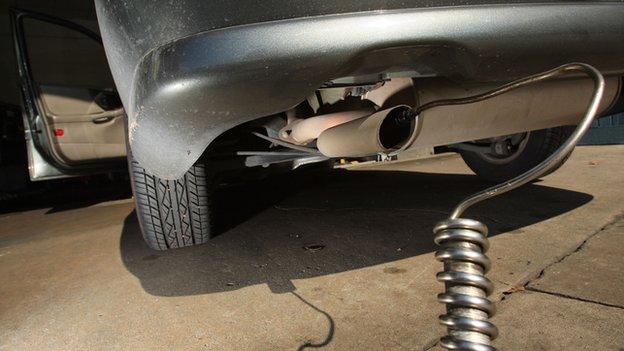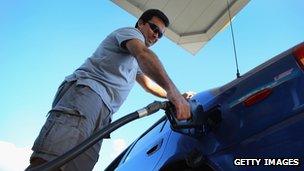'Carmakers manipulate emissions tests'
- Published

Results from official emissions and fuel economy tests do not tell the whole story, says a pressure group
Slick tyres are pumped hard to reduce rolling resistance. Brakes are adjusted, or at times even disconnected, to reduce friction. Cracks between body panels and windows are taped up to reduce air resistance. Sometimes they even remove the wing mirrors.
For carmakers, preparing for compulsory fuel efficiency and emissions tests has become a race in its own right, as they set out to make themselves look as clean and as frugal as possible.
"It's lots and lots of small tweaks," according to Greg Archer, clean vehicles manager with pressure group Transport & Environment.
"And they all add up."
All cars sold in the European Union go through official tests that measure fuel consumption and emissions of harmful emissions such as carbon dioxide (CO2) or nitrogen oxides (NOx).
The data is used by:
regulators who are forever tightening their criteria
governments for vehicle and road tax purposes
consumers eager to figure out how thirsty and how dirty their cars really are
In reality, however, the data is seriously and increasingly misleading, largely because the carmakers are getting better and better at manipulating the tests, according to a report by Transport & Environment, external.
"Consequently, there is a growing gap between what drivers achieve and what the tests really say about fuel economy and emissions," Mr Archer observes.
According to the official figures, average CO2 emissions from cars in the European Union fell from about 180g/km to less than 150g/km between 2001 and 2011. By comparison, real-world emissions fell from more than 190g/km to about 180g/km, according to data that German motorists fed into a comprehensive study by the International Council on Clean Transportation, cited by Transport & Environment.

"The gap between the real-world and official figures has been growing, year by year," said Mr Archer, pointing to how the 7% spread in 2001 increased to a 23% spread by 2011.
"Carmakers are misleading their customers by promoting fuel efficiency figures that they know will not be achieved."
Monique Goyens, director general of European consumer organisation BEUC, agrees.
"Car owners are misled about the benefits they can expect when buying an efficient vehicle today," she says. "Fuel consumption reductions achieved in laboratory conditions are not translated into monetary benefits for drivers."
But both motoring industry organisations and government bodies say the current system works as it provides an indication of different cars' fuel economy, which enables consumers to make comparisons and thus educated choices.
Major loopholes
The book of tricks available to carmakers during the tests includes techniques such as:
disconnecting the alternator, thus no energy is used to recharge the battery during the test
the use of special lubricants that are not used in production cars, in order to reduce friction
turning off all electrical gadgets such as the air-conditioning or the radio
And the tricks are widely used, according to Mr Archer.
"They didn't used to manipulate the tests, but they do now," he says.
"We're in a competitive situation, where carmakers compete to get the most favourable results in the tests."
There is no evidence that carmakers are breaking any formal rules, Transport & Environment points out. "But they don't need to," it says. "The current test procedures are so lax there is ample opportunity to massage the test results."
Indeed, under the New European Driving Cycle system, manufacturers are free to declare CO2 test results that are 4% below the measured results.
"We'll need to close these loopholes," says Mr Archer.
Transport & Environment's claim raises questions about the motor industry's assertion that modern cars are much more frugal and cleaner than cars made in the recent past.
Last year, for instance, UK industry body SMMT said "average UK new car CO2 emissions stood at 138.1g/km in 2011, down 4.2% on 2010". Its latest figures will be released on Wednesday.
'Outdated' test
Boasts such as this one exaggerate the actual improvements made, according to Transport & Environment.
"About half the official improvements in fuel efficiency during the last decade results from efforts made by carmakers during testing, rather than from real-life improvements," Mr Archer says.

Motoring costs are higher than official test results suggest
In reality, some models emit 50% more CO2 than the official figures claim, while others emit some 15% more than claimed. They also use more fuel, as noted by many a motoring journalist.
"We're starting to see parts of the specialist motoring press trying to produce reliable data," says Mr Archer.
The magazine What Car?, for instance, carried out its own tests and found that fuel economy figures produced by the government are routinely too optimistic.
To Mr Archer, it is obvious that the current test is "outdated, with lax procedures".
A new test, called the World Light Duty Test Cycle (WLTC), is under development and has been scheduled for introduction in 2016, though the motor industry is lobbying for its introduction to be delayed until 2021.
Once the new test comes into effect, it will become clear that carmakers no longer meet the regulatory targets set for them.
The targets were set on the basis of the old test, however, so "the regulatory targets should be changed to reflect the new test", Mr Archer insists.
On paper, this would seem like a relaxing of the rules, which could prove politically controversial.
Though in practice, Mr Archer points out, it would merely be a reflection of what is actually happening, rather than the current inaccurate indication.
You can follow Jorn Madslien's coverage of the motor industry on Twitter @jornmadslien, external.